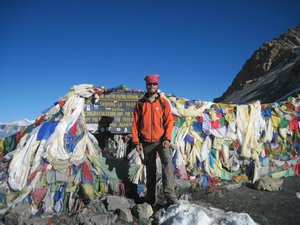Advertisement

 I made it!
I made it!
I reach Thorung La (5416m/17,800feet) just before 8 in the morning. It is a clear and sunny day. Despite the altitude it feels warm because of the piercingly strong sun. The Nepali view the Trans-Himalaya, the high altitude passes and valleys of the world's highest mountain range, with a great deal of reverence. Here the sun will burn exposed flesh within a few minutes, the wind can gust over 100 mph in the afternoons, and snowstorms can appear out of thin air. Someone flown in from sea level to a place like Thorung La (5416 M, 17800 feet) would die from lack of oxygen within 24 hours. It is one of the world's toughest environments for people to visit, but also one of the most beautiful.
I spent the last 21 days hiking the Annapurna Circuit and Base Camp treks in the Annapurna region of Nepal. In three weeks I covered over 200 miles of terrain ranging from low valleys similar in climate to Florida to the high altitude Thorung La pass where snow is present year round. I took a side trip to the stunningly beautiful Tilicho Lake at 4920 m/16,120 feet, and hiked into the Annapurna Sancturary before returning to Pokhara. Over the past three weeks I have had an enormously wide range of experiences ranging from watching the sunrise perched on a slope 3 miles high, to
getting stuck in a freak snowstorm high up on a ridge, to seeing a sheep sacrificed at a festival to appease a local spirit.
I try to make an effort to avoid cliched writing in this blog, so I will let the photos speak for themselves and refrain from describing this trek as the "experience of a lifetime" or the "most beautiful place ever". I will post a brief photo-journal outline of my trip here on this site. Anyone interested in seeing more photos of this region can check my facebook page where I will post a wider selection of pictures. I want these pictures to be accessible to the general public, so I will post a link to the facebook albums here on this site within the next couple days.
Thank you
Advertisement
Tot: 0.056s; Tpl: 0.015s; cc: 8; qc: 24; dbt: 0.0292s; 1; m:domysql w:travelblog (10.17.0.13); sld: 1;
; mem: 1mb

 I made it!
I made it!

































Catherine
non-member comment
wow
hey!! great pictures! how is the trekking going? and when are you going to come visit?